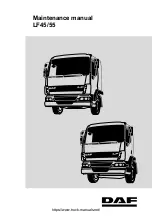
01–00 Safety Precautions
Safety Precautions in this section apply to all
procedures within this group.
DANGER
When working on the vehicle, shut down the en-
gine, set the parking brake, and chock the tires.
Before working under the vehicle, always place
jack stands under the frame rails to ensure the
vehicle cannot drop. Failure to follow these steps
could result in serious personal injury or death.
01–01 Engine Noise Panel
Inspection (Noise
Emission Control)
If equipped, inspect for torn engine noise panels.
See
for Caterpillar noise panel locations. If
panels are torn, replace them with new panels; see
Group 01
of the
Century Class Trucks Workshop
Manual
for procedures. Cummins M11 and N14 en-
gines, and Detroit Diesel Series 55 and Series 60
engines do not have engine noise panels.
01–02 Engine Drive Belt
Inspection
Worn or loose drive belts may cause premature
bearing failure or engine overheating. Excessive ten-
sion, or too little tension on the belt may result in ex-
cessive and premature belt wear. Poly-V belts, or
serpentine belts are retained by a belt tensioner that
requires no tension adjustment. Replace the belt if
any conditions described in "Visual Inspection" are
found. V-belts are installed as individual belts, and as
matched sets. When replacing matched sets of belts,
always replace both belts at the same time. Matched
belts must be from the same manufacturer. To in-
spect a belt, gently twist the belt to view the belt
sidewalls and bottom. Inspect all drive belts for the
following conditions, then perform the "Belt Tension
Inspection":
Visual Inspection
1.
Inspect the belt for glazing. See
, Ref. A.
Glazing is represented by shiny sidewalls, and is
caused by friction created when a loose belt slips
in the pulleys. It can also be caused by oil or
grease on the pulleys.
2.
Check the belt for ply separation. See
Ref. B. Oil, grease, or belt dressing can cause
the belt to fall apart in layers. Repair any oil or
coolant leaks that are affecting the belts before
replacing the drive belts. Do not use belt dress-
ing on any belt.
3.
Check the belt for a jagged or streaked sidewall.
See
, Ref. C. Jagged or streaked sidewalls
are the result of foreign objects, such as sand or
gravel in the pulley, or a rough pulley surface.
4.
Check for tensile breaks; breaks in the cord
body. See
, Ref. D. Cuts in a belt are usu-
ally caused by foreign objects in the pulley, or by
prying or forcing the belt during removal or instal-
lation.
5.
Check for uneven ribs on serpentine (poly-V)
belts. See
, Ref. E. Foreign objects in the
pulley will erode the undercord ribs, causing the
belt to lose its gripping power.
6.
Check the drive belts for cracks. See
, Ref.
F. Small irregular cracks are usually signs of an
old belt.
f011040
1
2
11/29/95
1.
Oil Pan Noise Panel (C10 engine only)
2.
Left-Side Noise Panel (3406 engine only)
Fig. 1, Caterpillar Engine Noise Panels
Engine
01
Century Class Trucks Maintenance Manual, January 2016
01/1
Summary of Contents for Argosy COE 2011
Page 1: ...Maintenance Manual CENTURY CLASS STI 341 1 A24 00691 000...
Page 3: ......
Page 5: ......
Page 11: ......
Page 33: ......
Page 35: ......
Page 41: ......
Page 43: ......
Page 45: ......
Page 47: ......
Page 49: ......
Page 53: ......
Page 63: ......
Page 67: ......
Page 69: ......
Page 77: ......
Page 79: ......
Page 91: ......
Page 103: ......
Page 111: ......
Page 113: ......
Page 123: ......
Page 125: ......
Page 129: ......
Page 135: ......
Page 149: ......
Page 159: ......
Page 161: ......
Page 165: ......
Page 167: ......
Page 175: ......
Page 179: ......
Page 183: ......
Page 191: ......
Page 193: ......

































